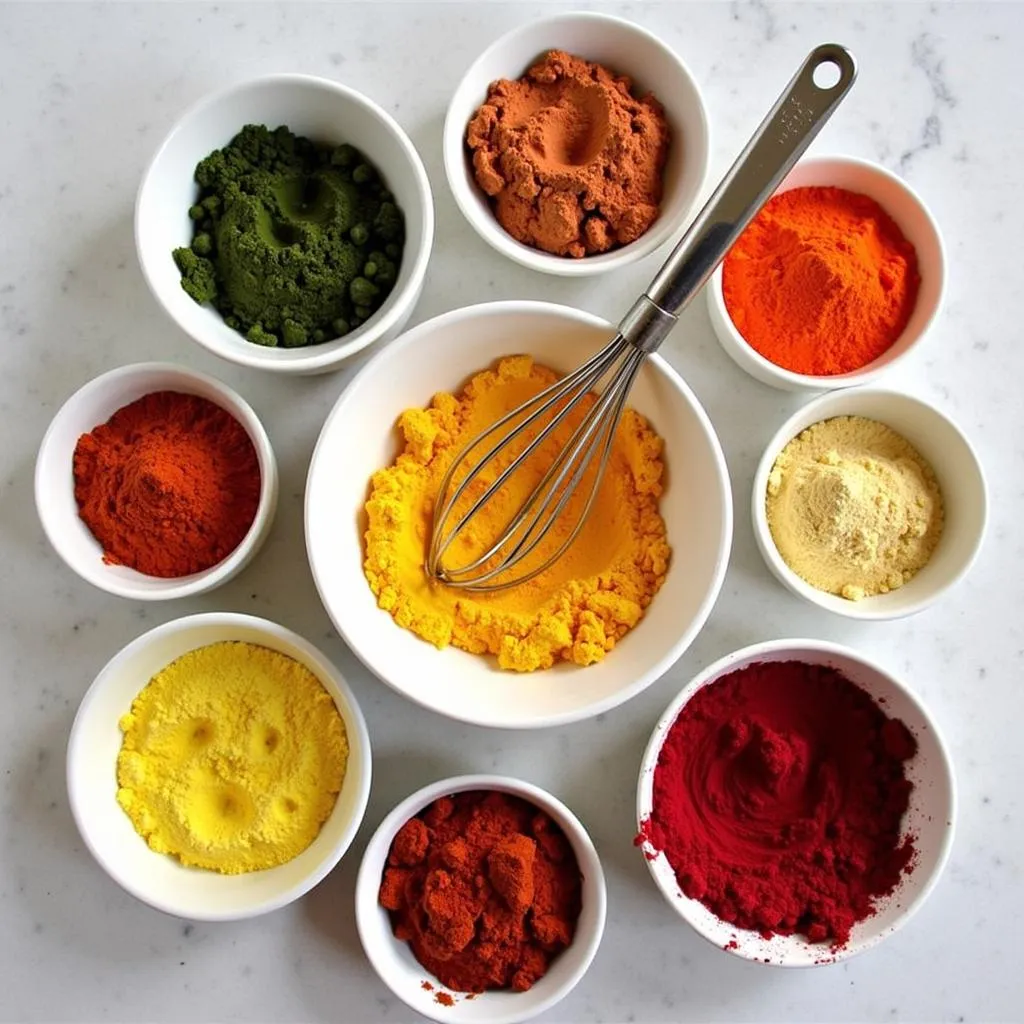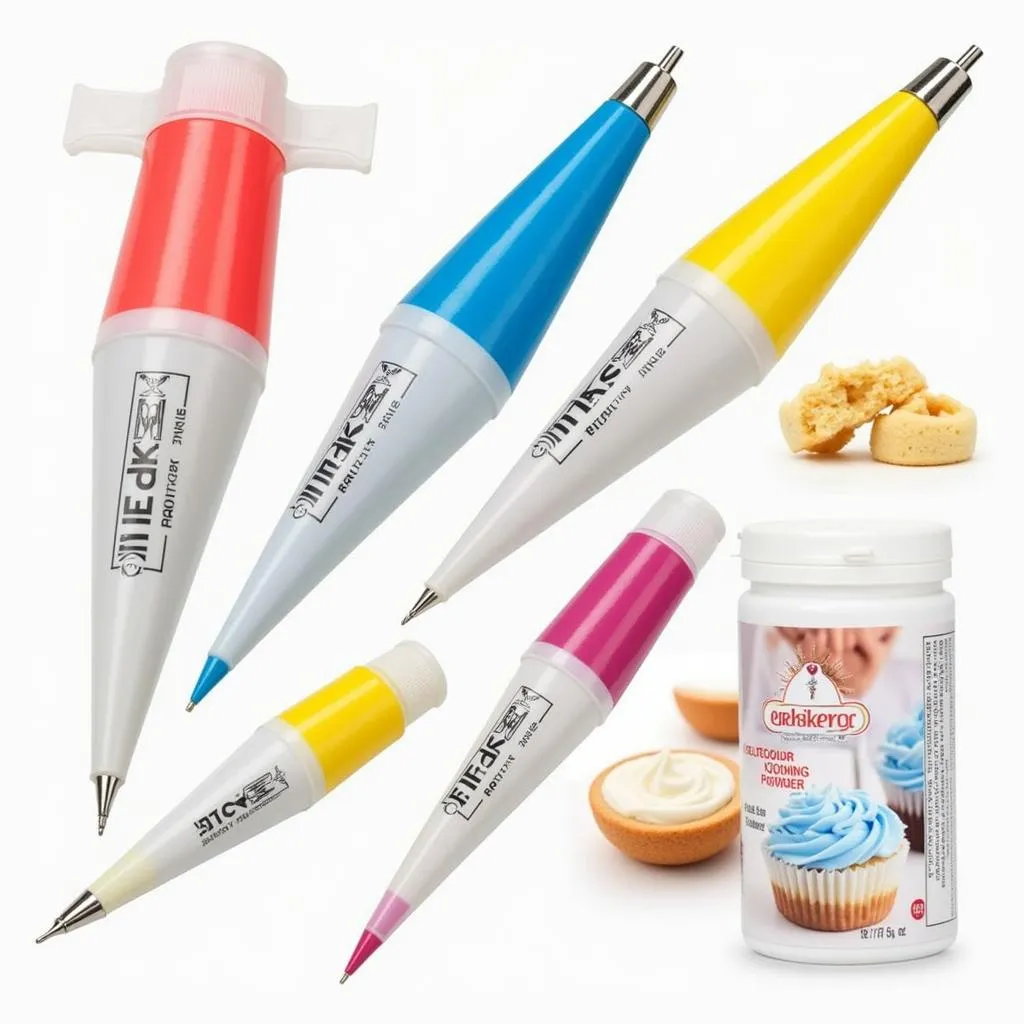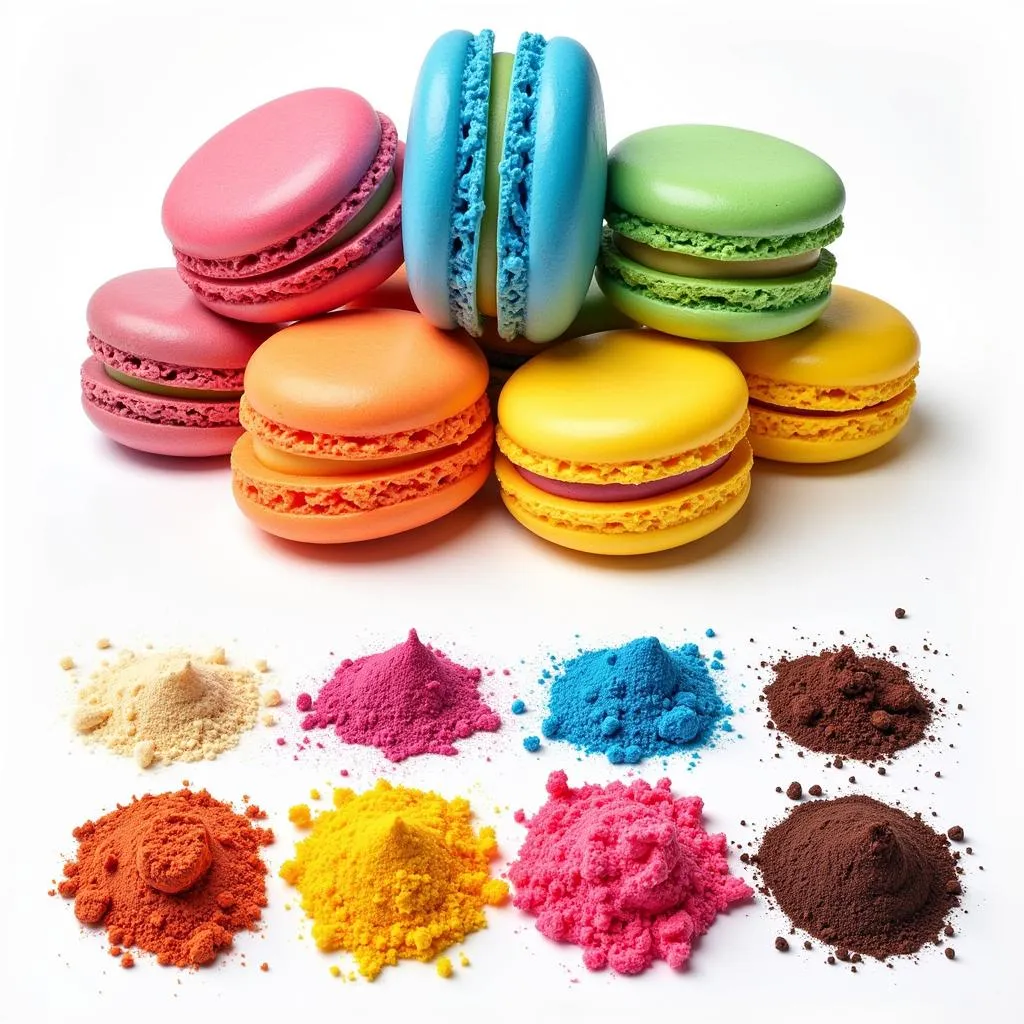Coloring Food Powder is a baker’s secret weapon, transforming ordinary treats into vibrant masterpieces. These concentrated pigments offer endless creative possibilities, from subtle pastel hues to bold, eye-catching shades. Whether you’re a seasoned pastry chef or a home baker looking to add a pop of color, understanding the different types and uses of coloring food powder can elevate your culinary creations.
 Bowls Filled with Various Coloring Food Powders
Bowls Filled with Various Coloring Food Powders
The Power of Pigment: Types of Coloring Food Powder
There are two main categories of coloring food powder: natural and artificial. Both have unique properties and applications, catering to different preferences and dietary needs.
Natural Coloring Food Powder: From Nature’s Palette
Derived from fruits, vegetables, spices, and other edible sources, natural coloring food powders offer a wholesome approach to food decoration.
- Turmeric: This golden spice not only adds warmth to curries but also imparts a sunny yellow hue to frostings, batters, and even savory dishes.
- Beetroot Powder: This vibrant powder, made from dried beets, creates stunning pinks and reds, perfect for red velvet cakes or a naturally pink frosting for your Valentine’s Day treats.
- Matcha Powder: Beyond its use in lattes and teas, matcha powder can lend its earthy green color to cakes, cookies, and even homemade ice cream, offering a unique flavor dimension. You can learn more about delightful matcha food pairing ideas on our blog!
While natural coloring food powders offer a healthier alternative, they might require a bit more experimentation to achieve desired shades, and their flavors, though often subtle, can influence the final taste of your creations.
Artificial Coloring Food Powder: A Spectrum of Possibilities
Artificial coloring food powders, often labeled as “lake” colors, are synthetically produced and prized for their intense hues and fade-resistant properties.
- Red food coloring powder: A staple for vibrant red velvet cakes, bright pink frostings, and festive holiday cookies.
- Blue Coloring Food Powder: This powder is your go-to for achieving deep ocean-inspired hues or creating a mesmerizing galaxy effect in your frosting.
Artificial coloring food powders offer unparalleled vibrancy and a wider range of colors. However, if you prefer a natural approach, exploring the world of natural pigments might be more appealing.
 Piping Bags Filled with Vibrant Frosting
Piping Bags Filled with Vibrant Frosting
Beyond Baking: Creative Uses for Coloring Food Powder
Coloring food powder isn’t just for cakes and cookies. Its versatility extends beyond traditional baking, adding a touch of whimsy and visual appeal to a variety of culinary creations.
Festive Celebrations with a Colorful Twist
From vibrant holiday cookies to themed birthday cakes, coloring food powder helps create unforgettable edible masterpieces for every celebration. Imagine a food coloring Christmas wonderland with vibrant green trees and red Santa hats made of frosting, all thanks to the magic of coloring food powder! Or perhaps a Paw Patrol birthday party food ideas with colorful treats inspired by the popular cartoon?
Transforming Everyday Dishes
- Homemade Pasta: Elevate your pasta night by incorporating spinach powder for a delicate green hue or beetroot powder for a touch of pink.
- Colorful Sauces: Add a pinch of turmeric to brighten up a creamy sauce or incorporate paprika for a subtle smoky flavor and a warm, reddish tint.
“Using high-quality coloring food powder allows for greater control over the intensity of the color, resulting in professional-looking results,” says renowned pastry chef, Emily Carter. “It’s about finding the right balance between visual appeal and preserving the integrity of the flavors.”
 An Assortment of Vibrant Macarons
An Assortment of Vibrant Macarons
Choosing the Right Coloring Food Powder
With numerous options available, selecting the right coloring food powder can feel overwhelming. Consider these factors to make an informed choice:
- Desired Color Intensity: Artificial colors generally offer bolder hues, while natural colors provide subtler shades.
- Dietary Restrictions: Opt for natural coloring food powders if you have allergies or follow a vegan or vegetarian lifestyle.
- Flavor Profile: Be mindful of potential flavor changes, especially when using natural coloring food powders.
Conclusion
Coloring food powder, whether natural or artificial, unlocks a world of creative possibilities in the kitchen. From vibrant cakes and cookies to colorful pasta and sauces, these concentrated pigments add a touch of magic and visual appeal to culinary creations. Experiment, explore, and let your imagination run wild with the endless possibilities of coloring food powder!
FAQs
1. Can I mix different coloring food powders to create custom colors?
Yes, you can combine different coloring food powders to achieve your desired shades. Start with small amounts and gradually add more until you reach the desired intensity.
2. How much coloring food powder should I use?
The amount varies depending on the desired color intensity and the type of food coloring powder used. Start with a small amount and gradually add more until you achieve the desired shade.
3. How do I store coloring food powder?
Store coloring food powder in airtight containers in a cool, dark, and dry place to preserve its vibrancy and prevent clumping.
4. What are some alternatives to using coloring food powder?
If you prefer a natural approach, explore using fruit and vegetable purees, juices, or spices to add color to your culinary creations. However, keep in mind that these alternatives might yield subtler hues compared to concentrated food coloring powders.
5. Can I use liquid food coloring instead of powder?
While liquid food coloring is a viable option, it can alter the consistency of batters and frostings due to its water content. Coloring food powder, on the other hand, offers greater control over color intensity without significantly affecting the texture of your creations.
Need further assistance with coloring food powder or any other baking inquiries? Don’t hesitate to contact us at Phone Number: 02437655121, Email: minacones@gmail.com, or visit us at 3PGH+8R9, ĐT70A, thôn Trung, Bắc Từ Liêm, Hà Nội, Việt Nam. Our dedicated customer support team is available 24/7 to assist you.
For more helpful baking tips and tricks, explore our other informative articles on natural purple food coloring and other exciting topics on our website!